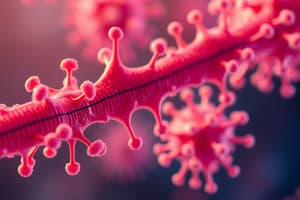Podcast
Questions and Answers
What does endocytosis primarily involve?
What does endocytosis primarily involve?
- Release of substances from the cell
- Increase in the number of receptors
- Uptake of molecules by cells (correct)
- Modification of receptor proteins
What is indicated by the up regulation of receptors?
What is indicated by the up regulation of receptors?
- Decrease in receptor availability
- Increase in receptor sensitivity (correct)
- Change in receptor structure
- Diminished cell response to stimuli
How can the affinity of an agonist be altered?
How can the affinity of an agonist be altered?
- By modifying receptor structure (correct)
- By increasing the concentration of antagonists
- By decreasing receptor numbers
- By inducing receptor degradation
What is a potential effect of active endocytosis in cells?
What is a potential effect of active endocytosis in cells?
Which best describes the concept of up regulation in pharmacology?
Which best describes the concept of up regulation in pharmacology?
What is the term used for receptor mutations that lead to activation without the presence of a ligand?
What is the term used for receptor mutations that lead to activation without the presence of a ligand?
Which of the following is NOT a cause of receptor mutations leading to constitutive activation?
Which of the following is NOT a cause of receptor mutations leading to constitutive activation?
How can receptor mutations that cause constitutive activation occur?
How can receptor mutations that cause constitutive activation occur?
What is a potential consequence of receptor mutations that lead to constitutive activation?
What is a potential consequence of receptor mutations that lead to constitutive activation?
Which statement about receptor mutations is true?
Which statement about receptor mutations is true?
What are the components of a G protein?
What are the components of a G protein?
What can cause receptors to be activated without any external stimulation?
What can cause receptors to be activated without any external stimulation?
In its normal resting state, what is the guanine nucleotide associated with the alpha subunit of the G protein?
In its normal resting state, what is the guanine nucleotide associated with the alpha subunit of the G protein?
What is a potential consequence of spontaneous receptor activation due to a mutation?
What is a potential consequence of spontaneous receptor activation due to a mutation?
Which of the following receptor types does the single chain amino acid receptor belong to?
Which of the following receptor types does the single chain amino acid receptor belong to?
What role does the G protein play when the receptor is activated?
What role does the G protein play when the receptor is activated?
Which condition exemplifies the issues caused by receptor mutation in the brain?
Which condition exemplifies the issues caused by receptor mutation in the brain?
What primarily triggers uncontrollable stimulation in patients with epilepsy?
What primarily triggers uncontrollable stimulation in patients with epilepsy?
What is the primary function of G protein coupled receptors?
What is the primary function of G protein coupled receptors?
What condition can lead to receptor mutation and consequent issues in the brain?
What condition can lead to receptor mutation and consequent issues in the brain?
What effect does creating an electrical charge change have on a cell?
What effect does creating an electrical charge change have on a cell?
Which process is NOT directly influenced by electrical charge changes in cells?
Which process is NOT directly influenced by electrical charge changes in cells?
How does electrical charge change impact muscle cells specifically?
How does electrical charge change impact muscle cells specifically?
What is a potential consequence of insufficient electrical charge changes in nerve cells?
What is a potential consequence of insufficient electrical charge changes in nerve cells?
Which of the following accurately describes the relationship between electrical charge changes and cellular function?
Which of the following accurately describes the relationship between electrical charge changes and cellular function?
What does Phospholipase C do in the context of G-proteins?
What does Phospholipase C do in the context of G-proteins?
Which G-protein class is NOT mentioned in the content?
Which G-protein class is NOT mentioned in the content?
In terms of G-protein classes, which class is associated with stimulating adenylate cyclase?
In terms of G-protein classes, which class is associated with stimulating adenylate cyclase?
What role do G-proteins play in cellular signaling?
What role do G-proteins play in cellular signaling?
Which statement correctly describes the relationship between Phospholipase C and G-proteins?
Which statement correctly describes the relationship between Phospholipase C and G-proteins?
Flashcards
Receptor Activation
Receptor Activation
A process where receptors become active without any external stimulus.
Abnormal Receptor Activity
Abnormal Receptor Activity
When receptors function improperly, leading to unintended activation without stimulation.
Receptor Mutation
Receptor Mutation
A change in the genetic code of a receptor, leading to altered function.
Epilepsy and Receptor Mutation
Epilepsy and Receptor Mutation
Signup and view all the flashcards
Muscle Spasms and Receptor Mutation
Muscle Spasms and Receptor Mutation
Signup and view all the flashcards
Constitutive Activation
Constitutive Activation
Signup and view all the flashcards
Spontaneous Mutations
Spontaneous Mutations
Signup and view all the flashcards
Disease-Related Mutations
Disease-Related Mutations
Signup and view all the flashcards
Experimental Mutations
Experimental Mutations
Signup and view all the flashcards
Up regulation of receptors
Up regulation of receptors
Signup and view all the flashcards
Down regulation of receptors
Down regulation of receptors
Signup and view all the flashcards
Change in agonist affinity
Change in agonist affinity
Signup and view all the flashcards
Endocytosis
Endocytosis
Signup and view all the flashcards
Active
Active
Signup and view all the flashcards
Electrical Charge Change
Electrical Charge Change
Signup and view all the flashcards
Cell Stimulation
Cell Stimulation
Signup and view all the flashcards
Nerve Signals
Nerve Signals
Signup and view all the flashcards
Muscle Contraction
Muscle Contraction
Signup and view all the flashcards
How is electrical charge change related to muscle contraction?
How is electrical charge change related to muscle contraction?
Signup and view all the flashcards
G protein-coupled receptors
G protein-coupled receptors
Signup and view all the flashcards
Alpha (α) subunit
Alpha (α) subunit
Signup and view all the flashcards
GDP
GDP
Signup and view all the flashcards
Single chain amino acid receptor
Single chain amino acid receptor
Signup and view all the flashcards
Type 2 G protein
Type 2 G protein
Signup and view all the flashcards
G-protein classes
G-protein classes
Signup and view all the flashcards
Phospholipase C
Phospholipase C
Signup and view all the flashcards
Study Notes
Pharmacology II Lecture Notes
- Course Details: Pharmacodynamics II, 2024-2025 academic year
- Lecturer: Dr. Shereen Refaie
- Date: November 2, 2023
- Objectives: Students should be able to describe the two-state receptor model, identify four types of drug receptors and their signal transduction mechanisms, detail the structure and pathway of G-protein coupled, tyrosine kinase, and nuclear receptors, and explain mechanisms controlling receptor density at the cell membrane.
The Two-State Receptor Model
- Receptors exist in two states: resting (R) and activated (R*).
- These states are in equilibrium.
- In the absence of a ligand, the equilibrium favors the resting state (R).
- Ligands (drugs, hormones, or enzymes) shift the equilibrium towards the activated state.
Agonists and Equilibrium
- Agonists bind to the resting state (R) and move the equilibrium towards the activated state (R*).
- This binding leads to a cellular response.
Constitutive Receptor Activation
- Receptors may be activated even without a ligand.
- This can be due to spontaneous mutations or disease states.
- This is termed "constitutive activation."
Inverse Agonists
- Inverse agonists bind to the activated state (R*) and shift the equilibrium to the resting state.
- This reduces receptor activity.
Receptor Types
- Type 1: Ligand-gated ion channels (ionotropic receptors) - fast neurotransmitters.
- Type 2: G-protein coupled receptors (GPCRs)
- Type 3: Tyrosine kinase receptors; important receptors for example insulin receptors.
- Type 4: Nuclear receptors - gene transcription.
G-Protein Signalling Mechanism
- Step 1: Ligand binds to the receptor.
- Step 2: Binding site fits ligand closely.
- Step 3: Receptor conformation change/Alpha subunit of the G-protein loses GDP.
- Step 4: GTP binds to the alpha subunit, causing it to detach from the beta/gamma subunits and the receptor.
- Step 5: Alpha subunit attaches to adenylate cyclase.
- Step 6: Activated alpha subunit activates adenylate cyclase.
- Step 7: Adenylate cyclase converts ATP to cAMP.
Tyrosine Kinase Receptors
- Extracellular: Drug binding site.
- Intracellular: Tyrosine kinase enzymes.
- Transmembrane: Connects the two parts.
- Two receptors merge -> phosphorylation of intracellular parts.
Nuclear Receptors
- Located inside the cell (cytoplasm or nucleus).
- Ligands are highly lipid-soluble, allowing them to pass through the cell membrane.
- Binding of ligands to receptors triggers gene activity -> delayed effects.
- Example: Steroid hormones (corticosteroids, sex hormones).
Desensitization and Tachyphylaxis
- Gradual decrease in drug response with repeated administration.
- Characterized by reduced receptor activity.
- Causes can include changes in receptors, mediator exhaustion, or increased metabolic degradation of the drug.
Tolerance
- Gradual decrease in responsiveness to a drug over days or weeks.
- Often associated with chronic drug use.
Control of Receptor Expression
- Up-regulation: Increase in receptor expression due to continuous inhibition.
- Down-regulation: Decrease in receptor expression due to continuous stimulation.
Quiz Questions and Answers
- (See pages 32-35 for specifics.)
Studying That Suits You
Use AI to generate personalized quizzes and flashcards to suit your learning preferences.




